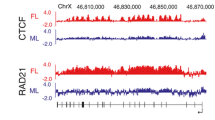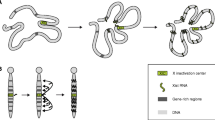Abstract
Female mammalian cells inactivate transcription from one of their X chromosomes to equalize gene expression of X-linked genes between males and females. Inactivation is a multistep process that involves a large non-coding RNA termed XIST, a variety of epigenetic modifications of chromatin, and alterations in protein composition such as enrichment of the histone variant macroH2A. We show here that inactive X chromosomes are also enriched in a well-characterized protein component of the nuclear scaffold, SAF-A. This protein has been implicated in chromatin organization, owing to its high specificity for scaffold-associated region (SAR)-DNA, in transcriptional regulation, e.g. of hormone-regulated genes, owing to its functional interaction with steroid receptors, and in RNA processing, owing to its interaction with RNA and heterogeneous nuclear ribonucleoprotein (hnRNP) particles. After near complete removal of DNA and associated chromatin proteins such as macroH2A, SAF-A remains with the “nuclear matrix”, still highlighting the former position of inactive X chromosomes. Interestingly, the enrichment of SAF-A in the inactive X chromosome depends on the RNA binding domain of the protein, the RGG box, raising the possibility that interaction of SAF-A with XIST RNA may contribute to the silencing of X-linked genes by local changes in nuclear architecture.






Similar content being viewed by others
References
Barr ML, Carr DH (1962) Correlation between sex chromatin and chromosomes. Acta Cytol 6:34–45
Boussif O, Lezoualc’h F, Zanta MA, Mergny MD, Scherman D, Demeneix B, Behr JP (1995) A versatile vector for gene and oligonucleotide transfer into cells in culture and in vivo: polyethylenimine. Proc Natl Acad Sci U S A 92:7297–7301
Brown CJ, Baldry SE (1996) Evidence that heteronuclear proteins interact with XIST RNA in vitro. Somat Cell Mol Genet 22:403–417
Brown CJ, Hendrich BD, Rupert JL, Lafreniere RG, Xing Y, Lawrence J, Willard HF (1992) The human XIST gene: analysis of a 17 kb inactive X-specific RNA that contains conserved repeats and is highly localized within the nucleus. Cell 71:527–542
Calapez A, Pereira HM, Calado A, Braga J, Rino J, Carvalho C, Tavanez JP, Wahle E, Rosa AC, Carmo-Fonseca M (2002) The intranuclear mobility of messenger RNA binding proteins is ATP dependent and temperature sensitive. J Cell Biol 159:795–805
Clemson CM, McNeil JA, Willard HF, Lawrence JB (1996) XIST RNA paints the inactive X chromosome at interphase: evidence for a novel RNA involved in nuclear/chromosome structure. J Cell Biol 132:259–275
Cohen SM, Brylawski BP, Cordeiro-Stone M, Kaufman DG (2003) Same origins of DNA replication function on the active and inactive human X chromosomes. J Cell Biochem 88:923–931
Costanzi C, Pehrson JR (1998) Histone macroH2A1 is concentrated in the inactive X chromosome of female mammals. Nature 393:599–601
Csankovszki G, Nagy A, Jaenisch R (2001) Synergism of Xist RNA, DNA methylation, and histone hypoacetylation in maintaining X chromosome inactivation. J Cell Biol 153:773–784
Dreyfuss G, Choi YD, Adam SA (1984) Characterization of heterogeneous nuclear RNA-protein complexes in vivo with monoclonal antibodies. Mol Cell Biol 4:1104–1114
Dreyfuss G, Matunis MJ, Pinol-Roma S, Burd CG (1993) hnRNP proteins and the biogenesis of mRNA. Annu Rev Biochem 62:289–321
Eggert H, Schulz M, Fackelmayer FO, Renkawitz R, Eggert M (2001) Effects of the heterogeneous nuclear ribonucleoprotein U (hnRNP U/SAF-A) on glucocorticoid-dependent transcription in vivo. J Steroid Biochem Mol Biol 78:59–65
Eggert M, Michel J, Schneider S, Bornfleth H, Baniahmad A, Fackelmayer FO, Schmidt S, Renkawitz R (1997) The glucocorticoid receptor is associated with the RNA-binding nuclear matrix protein hnRNP U. J Biol Chem 272:28471–28478
Eils R, Dietzel S, Bertin E, Schrock E, Speicher MR, Ried T, Robert-Nicoud M, Cremer C, Cremer T (1996) Three-dimensional reconstruction of painted human interphase chromosomes: active and inactive X chromosome territories have similar volumes but differ in shape and surface structure. J Cell Biol 135:1427–1440
Fackelmayer FO, Dahm K, Renz A, Ramsperger U, Richter A (1994) Nucleic-acid-binding properties of hnRNP-U/SAF-A, a nuclear-matrix protein which binds DNA and RNA in vivo and in vitro. Eur J Biochem 221:749–757
Gilbert SL, Pehrson JR, Sharp PA (2000) XIST RNA associates with specific regions of the inactive X chromatin. J Biol Chem 275:36491–36494
Göhring F, Schwab BL, Nicotera P, Leist M, Fackelmayer FO (1997) The novel SAR-binding domain of scaffold attachment factor A (SAF-A) is a target in apoptotic nuclear breakdown. EMBO J 16:7361–7371
Heard E, Rougeulle C, Arnaud D, Avner P, Allis CD, Spector DL (2001) Methylation of histone H3 at Lys-9 is an early mark on the X chromosome during X inactivation. Cell 107:727–738
Jeppesen P, Turner BM (1993) The inactive X chromosome in female mammals is distinguished by a lack of histone H4 acetylation, a cytogenetic marker for gene expression. Cell 74:281–289
Kiledjian M, Dreyfuss G (1992) Primary structure and binding activity of the hnRNP U protein: binding RNA through RGG box. EMBO J 11:2655–2664
Kim MK, Nikodem VM (1999) hnRNP U inhibits carboxy-terminal domain phosphorylation by TFIIH and represses RNA polymerase II elongation. Mol Cell Biol 19:6833–6844
Kipp M, Göhring F, Ostendorp T, van Drunen CM, van Driel R, Przybylski M, Fackelmayer FO (2000) SAF-box, a conserved protein domain that specifically recognizes scaffold attachment region DNA. Mol Cell Biol 20:7480–7489
Ma H, Siegel AJ, Berezney R (1999) Association of chromosome territories with the nuclear matrix. Disruption of human chromosome territories correlates with the release of a subset of nuclear matrix proteins. J Cell Biol 146:531–542
Martens JH, Verlaan M, Kalkhoven E, Dorsman JC, Zantema A (2002) Scaffold/matrix attachment region elements interact with a p300–scaffold attachment factor A complex and are bound by acetylated nucleosomes. Mol Cell Biol 22:2598–2606
Mattern KA, Humbel BM, Muijsers AO, De Jong L, Van Driel R (1996) hnRNP proteins and B23 are the major proteins of the internal nuclear matrix of HeLa S3 cells. J Cell Biochem 62:275–289
Mattern KA, van der Kraan I, Schul W, de Jong L, van Driel R (1999) Spatial organization of four hnRNP proteins in relation to sites of transcription, to nuclear speckles, and to each other in interphase nuclei and nuclear matrices of HeLa cells. Exp Cell Res 246:461–470
Mermoud JE, Popova B, Peters AH, Jenuwein T, Brockdorff N (2002) Histone H3 lysine 9 methylation occurs rapidly at the onset of random X chromosome inactivation. Curr Biol 12:247–251
Neri LM, Fackelmayer FO, Zweyer M, Kohwi-Shigematsu T, Martelli AM (1997a) Subnuclear localization of S/MAR-binding proteins is differently affected by in vitro stabilization with heat or Cu2+. Chromosoma 106:81–93
Neri LM, Zweyer M, Falcieri E, Bortul R, Martelli AM (1997b) Changes in the subnuclear distribution of two RNA metabolism-related proteins can be detected in nuclear scaffold or matrix prepared by different techniques. Histochem Cell Biol 108:525–536
Perche PY, Vourc’h C, Konecny L, Souchier C, Robert-Nicoud M, Dimitrov S, Khochbin S (2000) Higher concentrations of histone macroH2A in the Barr body are correlated with higher nucleosome density. Curr Biol 10:1531–1534
Plath K, Mlynarczyk-Evans S, Nusinow DA, Panning B (2002) Xist RNA and the mechanism of X chromosome inactivation. Annu Rev Genet 36:233–278
Renz A, Fackelmayer FO (1996) Purification and molecular cloning of the scaffold attachment factor B (SAF-B), a novel human nuclear protein that specifically binds to S/MAR-DNA. Nucleic Acids Res 24:843–849
Romig H, Fackelmayer FO, Renz A, Ramsperger U, Richter A (1992) Characterization of SAF-A, a novel nuclear DNA binding protein from HeLa cells with high affinity for nuclear matrix/scaffold attachment DNA elements. EMBO J 11:3431–3440
Verschure PJ, Van Der Kraan I, Enserink JM, Mone MJ, Manders EM, Van Driel R (2002) Large-scale chromatin organization and the localization of proteins involved in gene expression in human cells. J Histochem Cytochem 50:1303–1312
Wutz A, Rasmussen TP, Jaenisch R (2002) Chromosomal silencing and localization are mediated by different domains of Xist RNA. Nat Genet 30:167–174
Acknowledgements
We wish to express our thanks to John Pehrson (Department of Animal Biology, University of Pennsylvania, Philadelphia, USA) for antibodies against macroH2A. This work was supported by the Deutsche Forschungsgemeinschaft (DFG) through the priority program “Functional Architecture of the Cell Nucleus”, grant Fa376/1.
Author information
Authors and Affiliations
Corresponding author
Additional information
Communicated by I. Grummt
Rights and permissions
About this article
Cite this article
Helbig, R., Fackelmayer, F.O. Scaffold attachment factor A (SAF-A) is concentrated in inactive X chromosome territories through its RGG domain. Chromosoma 112, 173–182 (2003). https://doi.org/10.1007/s00412-003-0258-0
Received:
Accepted:
Published:
Issue Date:
DOI: https://doi.org/10.1007/s00412-003-0258-0




